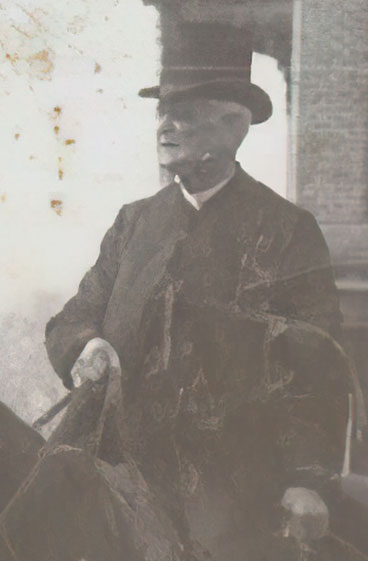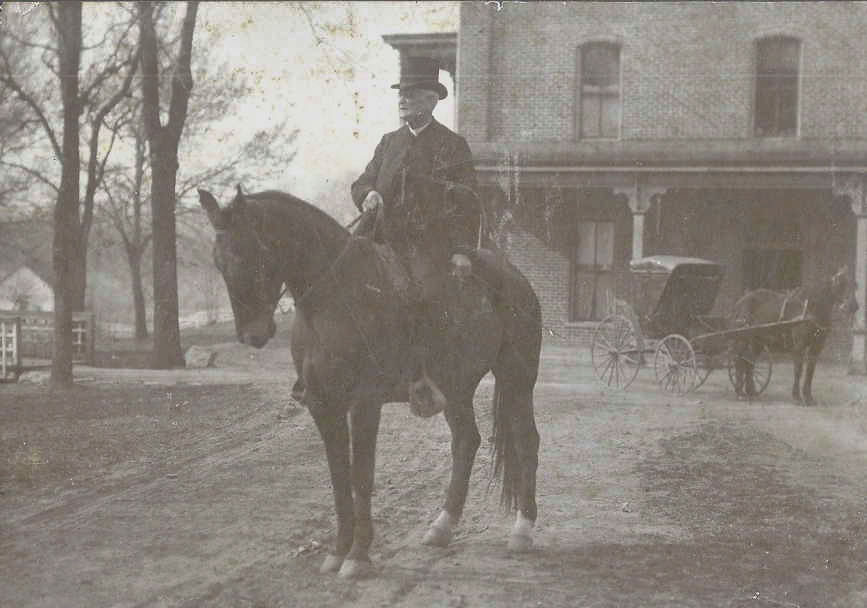By Trip Wiggins

Rev. Robert James McBryde
Born 1 Jun 1845/Abbeville, SC
Died 6 Sep 1916/Raphine, Rockbridge Co., VA
16th and 20th Rector of St. George’s
St. George’s: July 1877 – April 1883 & Nov 1905 – Oct 1912
Married: abt. 1871 Ellen Duvall Caldwell (1845-1918) (dau. of Rev. David Caldwell)
Buried Hollywood Cemetery, Richmond, VA
Served in Confederate Army (Private, 1st SC Cav, Co. G, Mar-Oct 1862)
College: University of Virginia
Virginia Theological Seminary (probably 1865-1868)
Deacon 1868
Priest 1869
Wm & Mary College Honorary DD (1883)
Parish History
University of Virginia, Chaplain (1868)
St. Luke’s Church/Lexington Parish, Rockbridge Co, VA (1869-1877)
St. George’s (1877-1883)
Latimer Parish (multiple churches), Rockbridge Co., VA (1883-1905) (per request of the bishop)
St. George’s (1905-1912)
For a priest with over 43 years of parish experience, it’s surprising on how little is available concerning his life and career. Notable is the fact that he served not once but twice as St. George’s rector – the only one to do that.
Rev. Robert J. McBryde was born June 1, 1845 in Abbeville, SC, the son of John and Susan McLaren McBryde. He was a first generation American as his parents emigrated from Scotland.
When the Civil War broke out (and he figured he was old enough to serve) he enlisted in the 1st South Carolina Cavalry, Co. G, (Confederate Army) in Abbeville on 15 March 1862. His career was short. The musters usually show him absent and six months after joining, the regimental surgeon recommended his discharge for chronic asthma. So much for his military career. It’s interesting to note in his obituary his war service is really played up although it appears he never actually participated in any battles/skirmishes.
In the mid-late 1860s he was enrolled in the University of Virginia where he graduated probably about 1865 and then moved on to the Virginia Theological Seminary in Alexandria graduating in 1868.
Following graduation he became a chaplain at his alma mater, the University of Virginia for one year.
He began his parish work as a deacon at St. Luke’s Church in Lexington Parish in Rockbridge County, VA. While there he was noted as being a strong force in razing and rebuilding the church that was consecrated by Bishop Francis Whittle in 1876.
Following the fallout between the St. George’s vestry and Rev. Dr. E.C. Murdaugh in April 1877, the vestry invited McBryde to Fredericksburg – which he immediately accepted. I. S. Davis of the University of Virginia had this to say about McBryde: his sermons were “faithful, searching and practical.” We were further informed that his gestures were easy and natural. If not conspicuously graceful, and his voice distinct and strong, if not musical. The university felt that McBryde had a “constant and consuming desire to win souls to Christ” which was the motive prompting everything the minister said. Furthermore, they continued, McBryde’s usefulness was promoted by the popularity of his wife, a “lovely person, in character and manners, as in appearance.”
He faced a daunting task as our rector. The charismatic Murdaugh had left with a third of the congregation, including 4 current members of the vestry, to start Trinity Church – more of a high church. His job – get the church back on an even keel.
Apparently the vestry was becoming more realistic about the changes overtaking the Episcopal Church for in early 1878 as a motion was carried to set aside an entire block of seats in the gallery for the “colored” people. We still weren’t a “free” church though as the vestry election of 1879 totaled 18 votes (probably still the pew rent holders).
He was not doing quite as well with the congregation as a whole. McBryde told the vestry in May, 1879, that he was greatly concerned by the criticism from a few of his communicants of his policy of bringing the lower classes into the church as members. He asked the vestry for their thoughts and they responded:
Resolved, That the Vestry of St. George’s Church Speaking in behalf, as they believe of the entire congregation, cordially invite all classes (sic) and colors of our Citizens to join with us in public worship and participation in all the benefits and sacraments of our Church.
Maybe we were starting to make real progress – but we were still “low church” as we also voiced our unanimous opposition to the division of the diocese and the approval of an assistant bishop. (The diocese of Southern Virginia will happen with our former rector, Rev. Randolph, as its first bishop.)
Sunday school must have been doing well for also in 1879 we purchased from a firm in Baltimore seventy-five new benches for the school.
In 1880 and 1881 McBryde was plagued with so much poor health that the congregation hired a supply minister (Dr. James Carmichael) to assist McBryde. Carmichael noted that he held fifty-five services, including forty-nine at which he preached; prepared nine candidates for confirmation; officiated at four baptisms; and conducted two funerals in the spring of 1881. McBryde’s poor health would continue throughout the remainder of his service here.
His departure was also out of the ordinary. He left in 1883 because the bishop felt that McBryde’s great influence with young men made him peculiarly qualified to be the rector at Lexington, VA (the home of Washington & Lee University). In his letter of resignation McBryde asserted that he had been sent to Fredericksburg to remove, as far as possible, all discordant elements in St. George’s – due to the split. He had been assured that he was leaving a united congregation.
So he left for Lexington, or more properly Rockbridge County. He would be the rector for four churches in Latimer Parish – Christ Church, St. John’s Church, Trinity Church, Grace Memorial Church and Robert E Lee Memorial Church. Quite a task. That same year his alma mater awarded him a Doctorate of Divinity for all his service.
But he’ll return to Fredericksburg one last time!
Following 22 years in the Lexington area, he was again called to St. George’s and, again, accepted. His predecessor, Rev. William D. Smith had left in the spring of 1905 and St. George’s was using as a supply the Rev. S. K. Bailey until McBryde returned in November.
Notable events in his second term included John Waterhouse Herndon of Alexandria purchasing and installing a gilded copper cross for the church spire as a memorial to his grandfather, the late John Waterhouse. It was installed in 1909. In 1908 the vestry accepted the offer of Mrs. Victoria Wallace to obtain and install nine stained glass windows.
In 1909, the rector’s guild (forerunner of the Altar Guild) petitioned the vestry to use a brass cross and vases for flowers on the Holy Table in the nave. One vestry member moved that the request be granted providing flowers were used only on feast days. On a full vote of the vestry it was approved without the restriction.
We still could have a little controversy. In 1906, Mr. A. R. Howard moved that the vestry should employ Mr. Houston K. Sweetser to sing in the St. George’s choir for $6 per month. As of 1951 he was still in the choir and had been a vestryman twice. There is no record as to when he was no longer a paid choir member. Quenzel notes there were friction in the choir in 1910 but no specifics mentioned. Could it be that one member was paid and the rest volunteers?
By the spring of 1912, McBryde was in deteriorating health. A supply was called (Rev. R.S. Litsinger) to assist. By April Litsinger was listed as an assistant rector. Because of his “inability to meet the needs of the congregation” McBryde submitted his resignation in October 1912.
The vestry reluctantly approved his request but wrote him that the ability, culture and sincerity of his preaching had been:
A benediction not only to your congregation, but to the community, and your kind and sympathetic nature at their firesides has rooted a reciprocal attachment in the hearts of the members of St. George’s Church which can never be eradicated.
They told the rector that he was leaving behind not only a record of spiritual good work, but also beautiful and otherwise improved church buildings.
Following his retirement he lived in Kentucky but went for visits to his old familiar area of Rockbridge County. It was while visiting there that he died on 6 September 1916. He was laid to rest in Hollywood Cemetery in Richmond next to his wife.
Sources:
Quenzel, Carrol. The History and Background of St George’s Episcopal Church Fredericksburg, Virginia (1951)
St. George’s Vestry Minutes
St. Luke’s Church, Pedlar Mills, VA (http://www.stlukespedlarmills.net/history.html)
Ancestry.com (photo, census, marriage, Virginia death certificate)
Fold3.com (military record)
Journal of the Convention of the Episcopal Church, Diocese of Virginia (various years)
Newspapers.com (various newspapers/dates)
Fredericksburg Daily Star; 7 Sep 1916; obit (CRRL, Virginiana Room)
Find-a-grave.com
